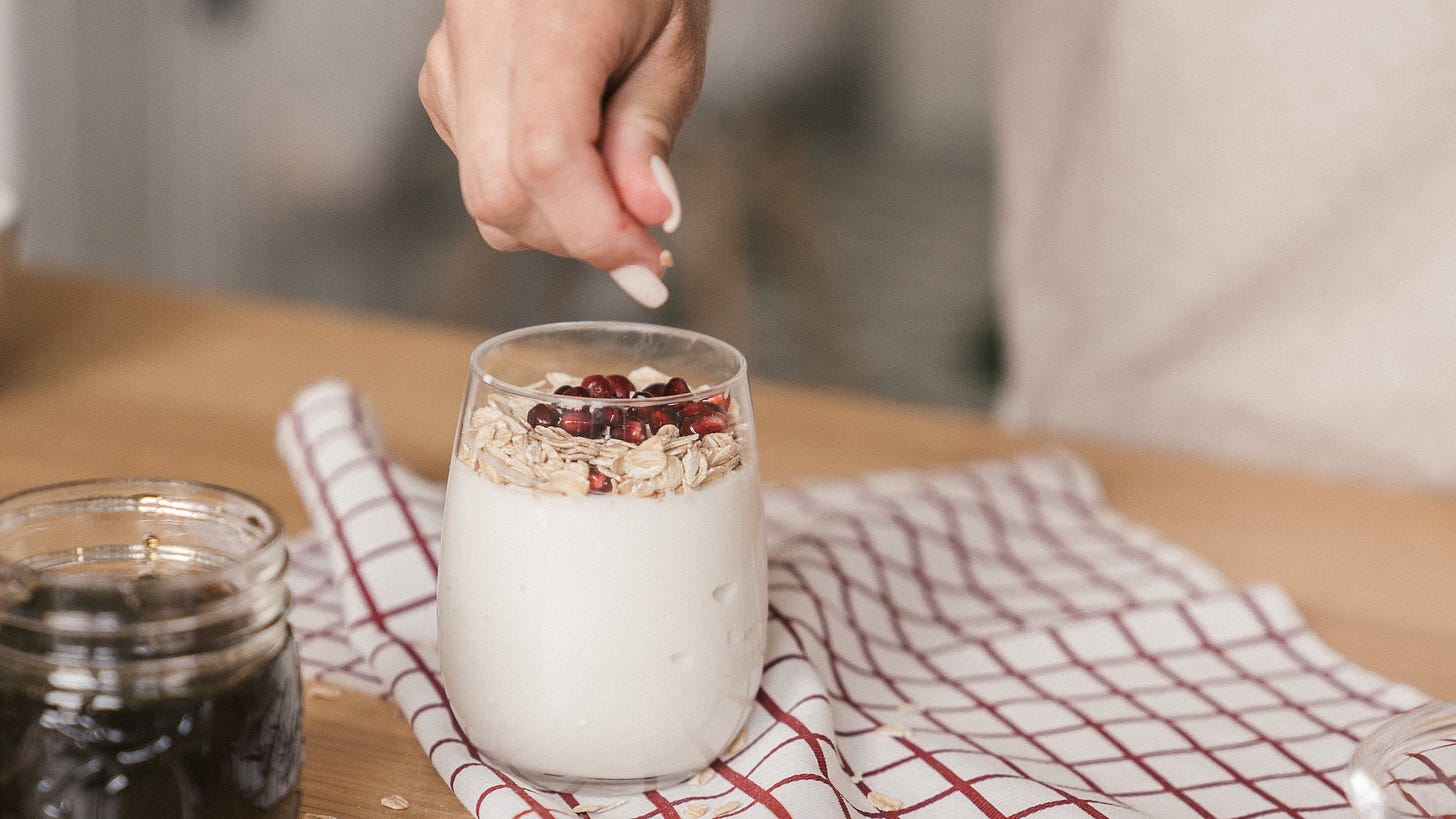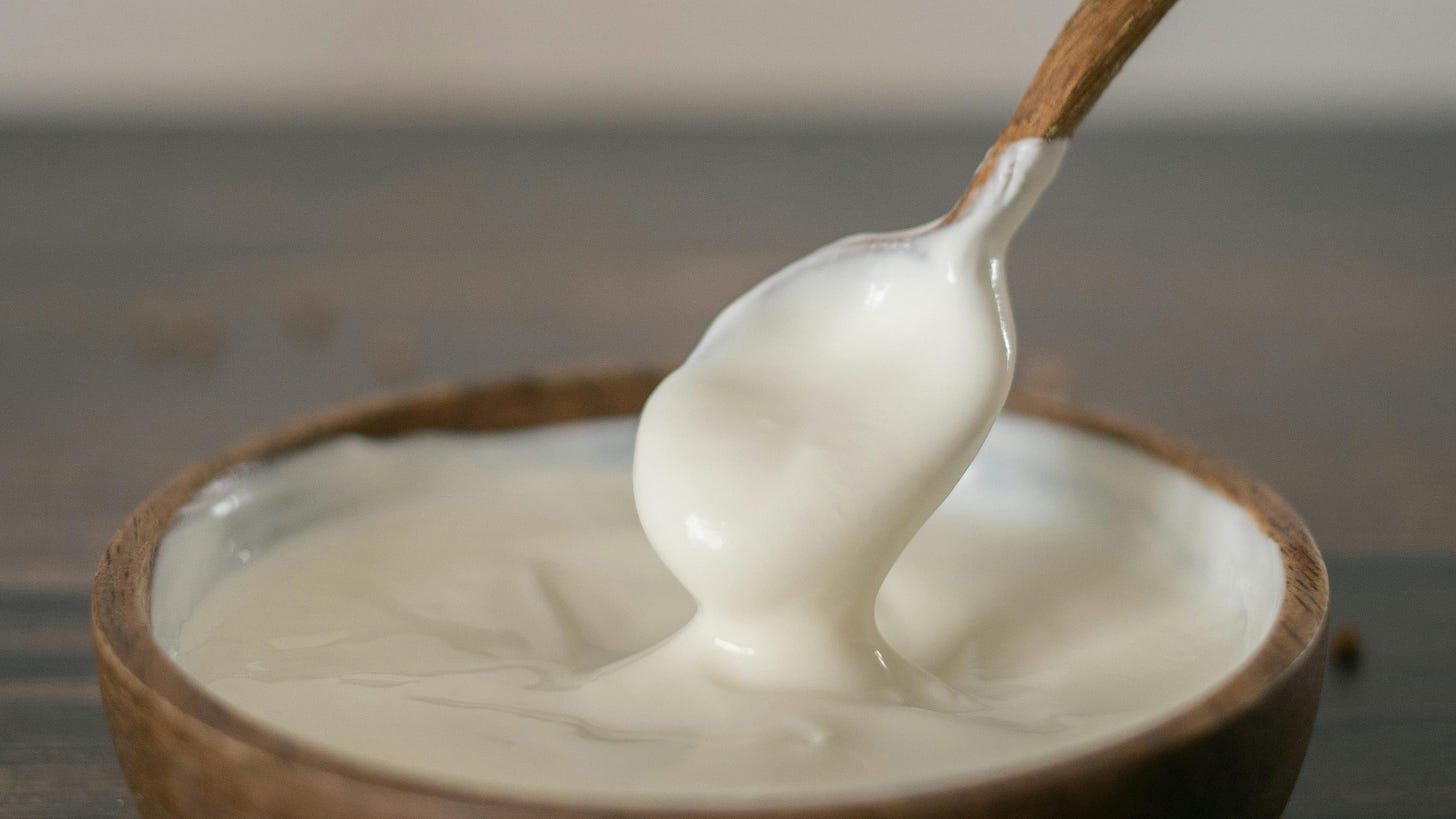I know not everyone is a fan of dairy, but as a dietitian, and personally, I love it! So much nutrition packed in a small and tasty package! And maybe you’ve found yourself standing in the dairy aisle wondering, should I use plain Greek yogurt or sour cream in my recipe?
Generally, I opt for plain Greek yogurt, but let's dive into the details, comparing plain Greek yogurt vs sour cream in terms of taste, nutritional value, versatility, and overall culinary charm.
First stop, production and taste!
Production Process and Taste Test
Plain Greek Yogurt vs Regular Yogurt
Greek yogurt and regular yogurt share a common origin – both are dairy products made from milk that undergoes a fermentation process using beneficial bacteria.
The two main types of bacteria commonly used in the yogurt-making process are Lactobacillus bulgaricus and Streptococcus thermophilus. These bacteria work together to change lactose, the natural sugar in milk, into lactic acid.
After fermentation, regular yogurt is typically not strained, which is why it retains more liquid whey. This results in a creamier but thinner consistency. Greek yogurt however is strained to remove excess whey, resulting in a thicker, more concentrated yogurt with a creamy texture.
Since the straining and fermentation process reduces the amount of lactose in Greek yogurt, it may be easier to digest for anyone with lactose intolerance.
Plain Greek yogurt has a tangy and slightly sour taste, along with a rich and creamy texture. It offers a clean and fresh flavor profile with hints of natural sweetness, balanced by its refreshing tartness. It is a versatile ingredient in various dishes including smoothies, dips, and soups.
Sour Cream
Now, let's talk about sour cream – the classic companion to baked potatoes and tacos.
Sour cream begins with heavy cream, typically derived from whole milk. For safety, the cream undergoes pasteurization, a heat treatment that eliminates harmful bacteria.
Next, lactic acid bacteria, specifically Streptococcus lactis and Streptococcus cremoris, are introduced. These bacteria play a crucial role in fermenting the lactose in the cream, transforming it into lactic acid.
During fermentation, the cream undergoes changes that produce the characteristic tangy flavor of sour cream, accompanied by the desired thickening and coagulation. Following this, the sour cream is cooled to halt bacterial activity and maintain its texture.
Sour cream tastes rich and indulgent with a pronounced tang. It adds a luxurious touch to dishes, offering a creaminess that's more decadent than Greek yogurt. If you're looking for that traditional, comforting flavor, sour cream might be your go-to.
So now you know how they are made and how they taste, but what about nutrition?
Nutritional Face-Off: Plain Greek Yogurt vs Sour Cream
Though they often look and taste similar, plain Greek yogurt and sour cream have different nutritional characteristics.
Plain Greek Yogurt
When it comes to nutritional content, plain Greek yogurt takes the spotlight. It's a protein powerhouse, packing in more protein per serving than sour cream.
Additionally, Greek yogurt can be rich in probiotics (check the label to be sure), promoting gut health and aiding digestion.
In one serving of plain Greek yogurt (which is a little over ½ cup or 155 g) you get (1):
95 calories
16 g protein
0.5 g fat
5.7 g carbs
173 mg calcium
Plain Greek yogurt is also a good source of many B vitamins, including B12, riboflavin (B2), and pantothenic acid (B5).
Sour Cream
One major difference between Greek yogurt and sour cream is fat. Sour cream has a much higher fat content which gives it that velvety texture and rich flavor. Moderation is key if you’re watching your fat intake.
In a similar serving of sour cream (about ½ cup) you get (2):
200 calories
2.5 g protein
19 g fat
4.6 g carbs
100 mg calcium
Like Greek yogurt, sour cream also provides many B vitamins (though in small amounts) and is a good source of Vitamin A (124 µg or about 15% of your daily needs).
Health Considerations
Plain Greek Yogurt
For those prioritizing health benefits, plain Greek yogurt delivers. Its high protein content makes it an excellent choice for promoting satiety and supporting:
Muscle. Getting plenty of protein in your diet helps maintain and build muscle mass (bonus points if you add resistance training). Muscle boosts your metabolism and balances glucose levels, potentially helping you avoid diabetes (3).
Bone. In addition to protein, calcium is crucial for maintaining strong bones, and Greek yogurt has both.
Gut. The probiotics present in Greek yogurt contribute to a healthy gut microbiome, enhancing overall digestive wellness.
Helpful Hint: Not all Greek yogurt contains probiotics. Look for the words “Live active yogurt cultures” or the specific names of the cultures on the label.
Mind. Consistently eating probiotic yogurt has been linked with decreased depression, anxiety, and stress (4). Sign me up!
But what about sour cream?
Sour Cream
While sour cream may not match Greek yogurt in terms of protein, it does provide essential fats and a satisfying taste and texture. The fat may help your body better absorb fat-soluble vitamins like D, E, and K.
Though both are milk products, sour cream generally doesn’t provide the same quantity of vitamins and minerals as plain Greek yogurt, although you do get some B vitamins and Vitamin A. And sour cream usually doesn’t contain probiotics.
So while it's fine to enjoy sour cream in moderation, it doesn’t provide the same nutritional impact as plain Greek yogurt. However, its indulgent nature can be a delightful treat when used wisely.
Now let’s look at how these two dairy delights work for meal prep!
Versatility in the Kitchen
Plain Greek Yogurt
The versatility of plain Greek yogurt knows no bounds. It seamlessly transitions from breakfast to dinner, playing a starring role in both sweet and savory dishes.
You can use it as a creamy base for smoothies, a topping for granola, or as a great substitute for mayonnaise in savory recipes. Its thick consistency also makes it a fantastic addition to dips and salad dressings. And it can pinch hit for milk in your baked goods.
Plain Greek yogurt can even be used to make a healthier alternative to many cream sauces. Even if you use the full-fat version, your sauce will have fewer calories and more protein than one made with heavy cream or sour cream. Pasta Alfredo anyone?
Sour Cream
Sour cream excels in lending a luscious touch to a variety of dishes. It's the classic topping for baked potatoes, tacos, and nachos, adding a decadent creaminess. Sour cream can also be incorporated into both sweet and savory recipes, offering a rich and tangy flavor profile.
Sour cream is also excellent for baking. Adding more moisture than plain milk, plus a bit of zing, it’s popular in cake recipes.
Plain Greek Yogurt vs Sour Cream: Who Wins?
In the great debate of sour cream vs yogurt, I give the gold to plain Greek yogurt (sorry sour cream 🙁). It's generally a better choice in place of sour cream for a healthy diet. If you're seeking a protein-packed, probiotic-rich option with a milder taste, you can’t go wrong.
But, if you crave richness, creaminess, and a pronounced tang, sour cream is the classic choice. And though higher in fat and calories, it’s not without its merits.
Not sure you can give up your regular sour cream? Try a mix. Instead of a cup of sour cream, use ½ cup plus ½ cup plain Greek yogurt.
Whether you're whipping up a healthy breakfast parfait or indulging in a decadent taco night, both plain Greek yogurt and sour cream can have a place in your culinary arsenal.











